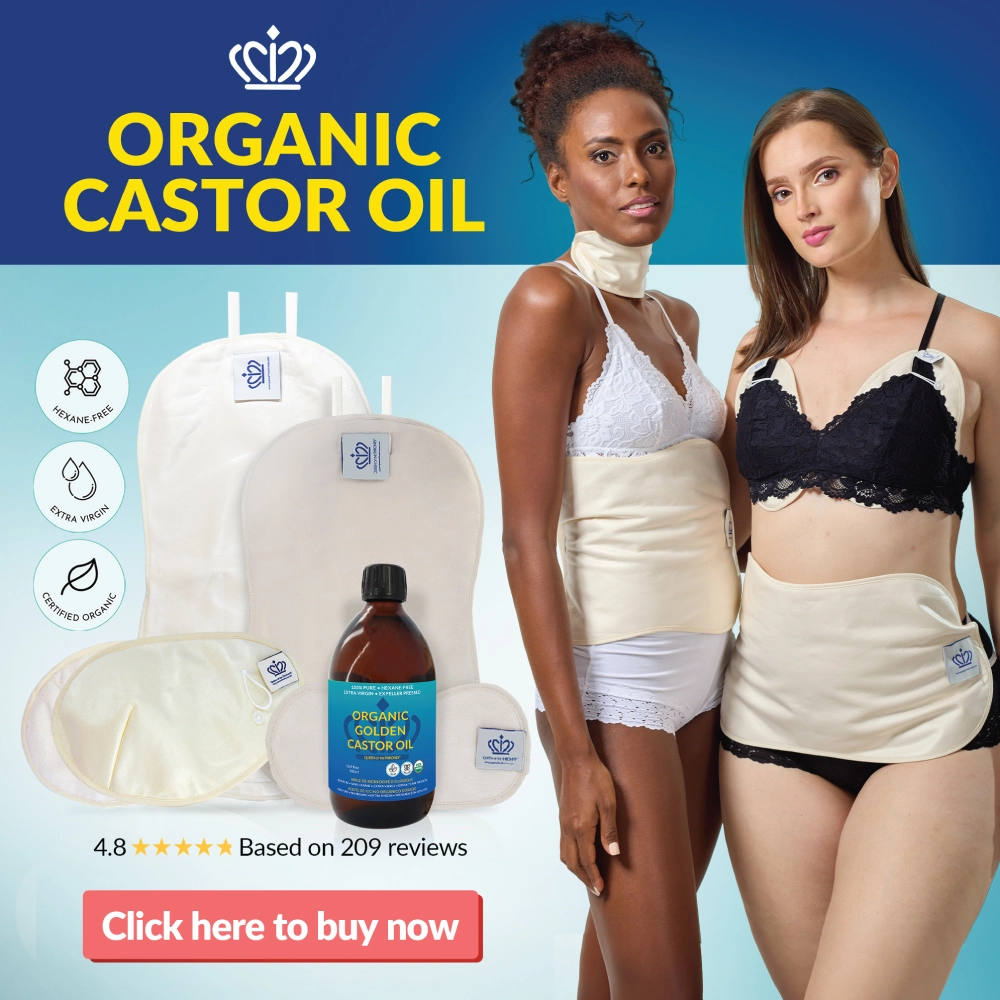How Castor Oil May Help Support Bone Spurs
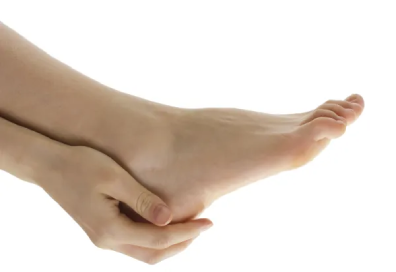
How Castor Oil May Help Support Bone Spurs
Written by: Heather Tanti R.P.N (non-practicing)
Medically reviewed by: Melanie Swackhammer B.A.
Have you or someone close to you been struggling with bone spurs? Bone spurs, or osteophytes, are bony growths that form in your joints or in the spine, and have the potential to cause significant pain and discomfort in your daily life.
Because some bone spurs can cause little to no symptoms, they can go undetected for years, and may never require treatment. But what about the ones that do? What can be done to help support this condition?
While surgery is often the line of treatment, many individuals find themselves seeking natural support, can you relate?
Keep reading to discover more about this frustrating phenomenon, and how Castor Oil may bring gentle, natural support to this condition.
What causes bone spurs?
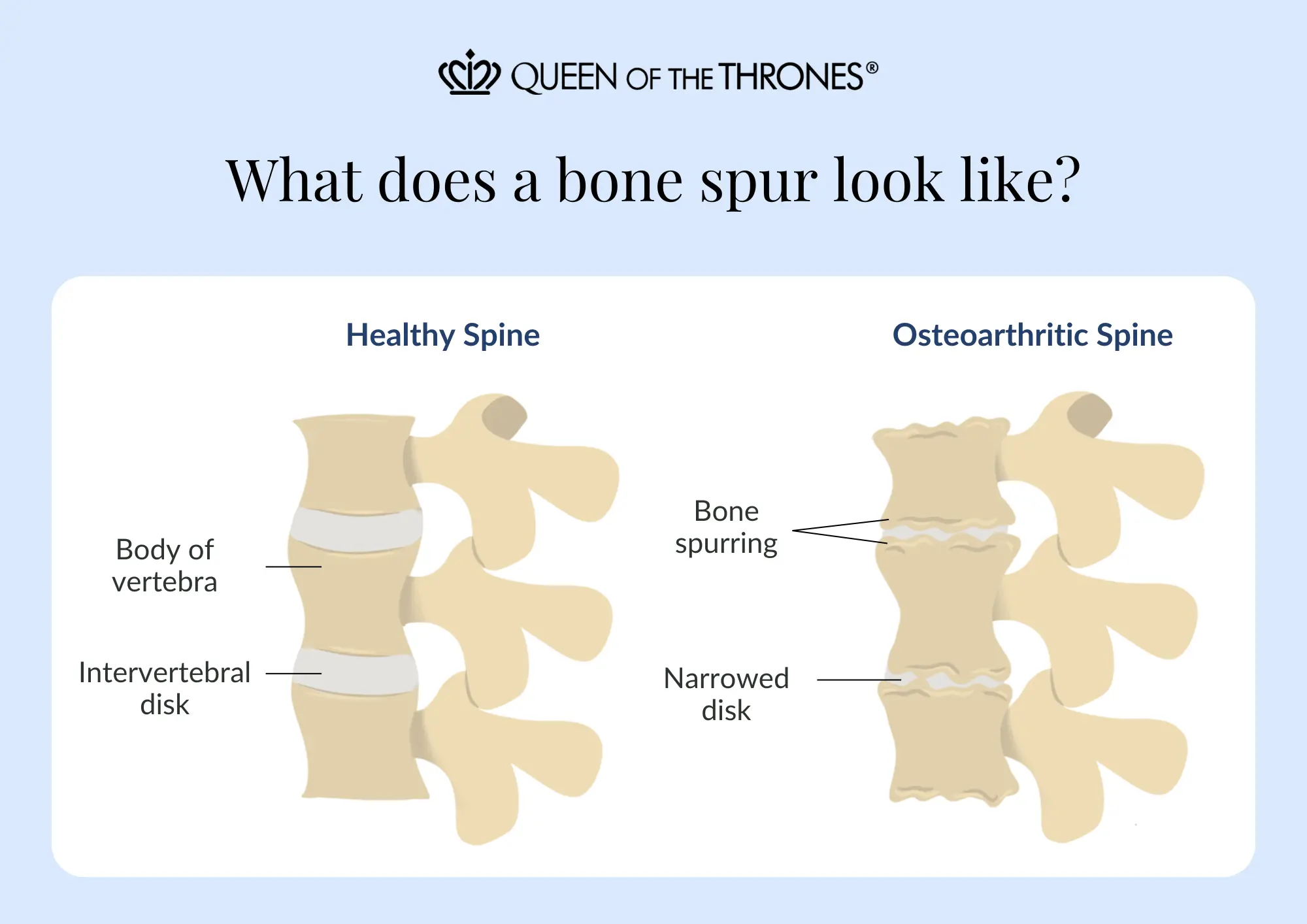
Aging is also a natural component to the formation of bone spurs. As our discs wear down over time, the ligaments become looser and can’t support the joints as well.
To compensate, the body tries to thicken the ligaments to hold the bones together. Over time, these thicker ligaments start forming bits of bone.
This combination of thickened ligaments and new bone around the spinal cord and nerve roots puts pressure on them.2
Aging also contributes to the breakdown of the joints, which may lead to inflammation, pain, stiffness, and deformity.
Some other factors to consider in the formation of bone spurs include:
- Obesity: Excess body weight can exert increased stress on joints, leading to wear and tear on cartilage. This mechanical strain may contribute to the development of bone spurs over time.3
- Nutrition: Dietary factors play a role in joint health. Inadequate intake of essential nutrients, particularly those crucial for cartilage maintenance, may contribute to the degeneration of joints and the subsequent formation of bone spurs.4
- Vitamin D deficiency: Insufficient levels of vitamin D, a vital nutrient for bone health, can impair the body’s ability to maintain proper bone density and structure. This deficiency may exacerbate the formation of bone spurs in affected joints.5
- Injury: Traumatic events, such as joint injuries or repetitive stress, can initiate a cascade of changes in the affected area. This may include the overgrowth of bone as a reparative response, potentially leading to the formation of bone spurs.6
- Poor posture: Improper body alignment and sustained poor posture can contribute to abnormal stress on joints. Over time, this can lead to the degeneration of cartilage and the subsequent development of bone spurs in an attempt to stabilize the affected joints.7
Types of bone spurs
Bone spurs, or osteophytes, can take on various forms, highlighting their diversity. It’s essential to know that there isn’t a one-size-fits-all description for these abnormal bony growths.
They can appear in different shapes and places throughout the body. From heel spurs linked to plantar fasciitis to those forming around joints in conditions like osteoarthritis, bone spurs come in different types.
Bone spur in heel

The typical indication of a calcaneal spur is talalgia, more commonly recognized as heel pain.
Calcaneal spurs are linked to various health conditions. They are considered a cause of plantar fasciitis, can be related to weight gain, and may be a complication in conditions like arthritis, gout, high arches (pes cavus), and flat feet (pes planus).8
Bone spur in knee joint
While some people with knee bone spurs may not experience symptoms, others may feel pain, swelling, or limited mobility, depending on the size and location of the spurs.
Bone spur in knee joint
In older adults, osteoarthritis is common and can lead to bony outgrowths called osteophytes on the vertebrae. The symptoms of these vertebral osteophytes depend on where they are in the spine.
For example, in the neck (cervical region), osteophytes might affect the throat and swallowing, causing difficulties (dysphagia) and other issues like food going into the airway, vocal cord problems, and disrupted sleep (obstructive sleep apnea).
Apart from these, osteophytes can also form at the back and sides of the vertebrae, potentially pressing on the spinal cord and limiting the blood supply to the vertebral artery.10
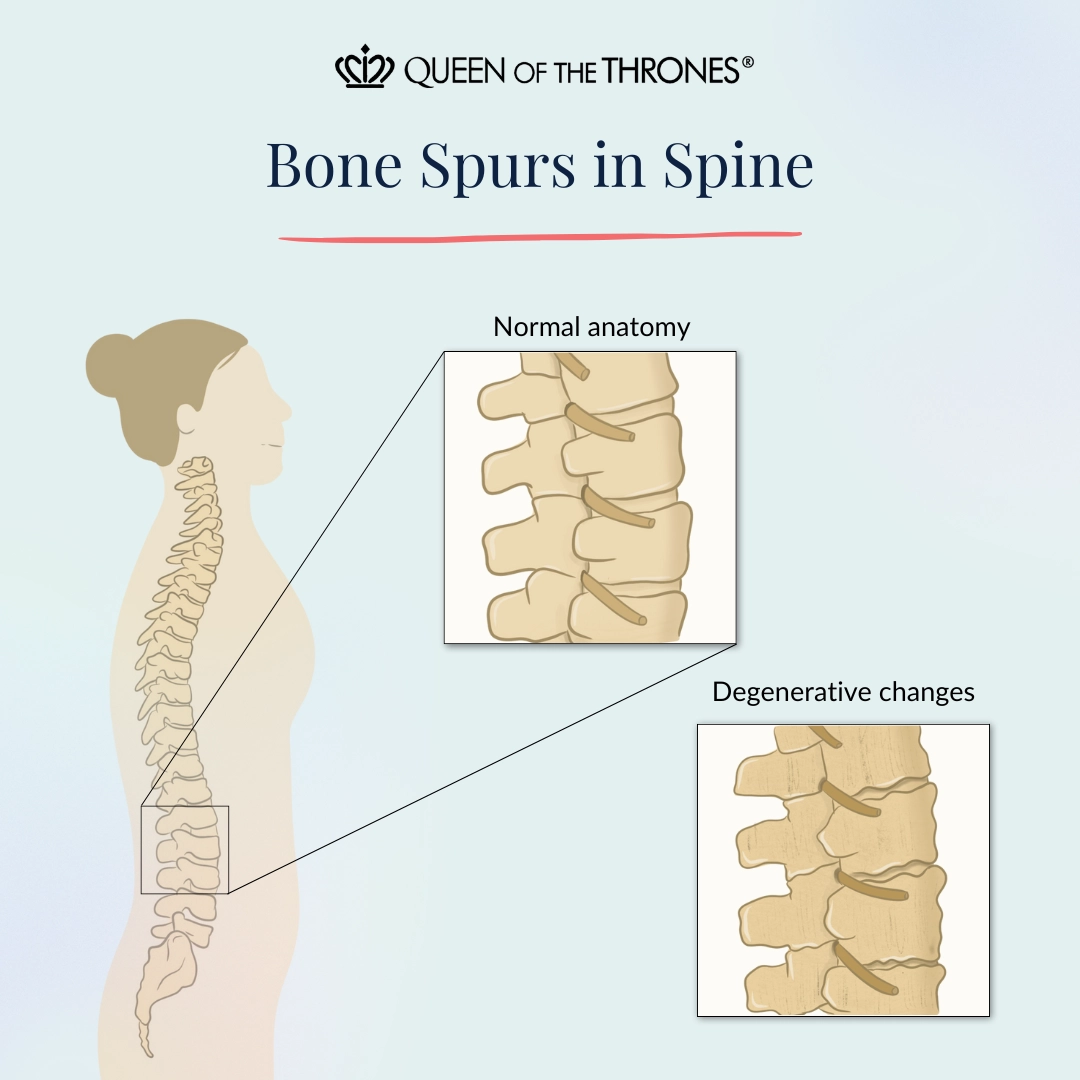
Bone spur in the wrist
Wrist bone spurs are extra bits of bone that can show up in or around the wrist joint. They often happen when the wrist joint goes through wear and tear.
These bony growths can form near the edges of the bones in the wrist. Some people might not feel anything with wrist bone spurs, but others may experience pain, swelling, or difficulty moving the wrist. Sometimes, these bone spurs can be linked to conditions like arthritis and carpal tunnel.
Treatment for bone spurs
Non-surgical methods such as physical therapy and lifestyle modifications may also be considered to manage the condition. However, if these measures prove insufficient and the osteophytes persist, surgical intervention may be recommended.
Surgical removal aims to address the bony growths directly and is typically considered when conservative measures fail to provide adequate relief or when there’s a significant impact on joint function.11
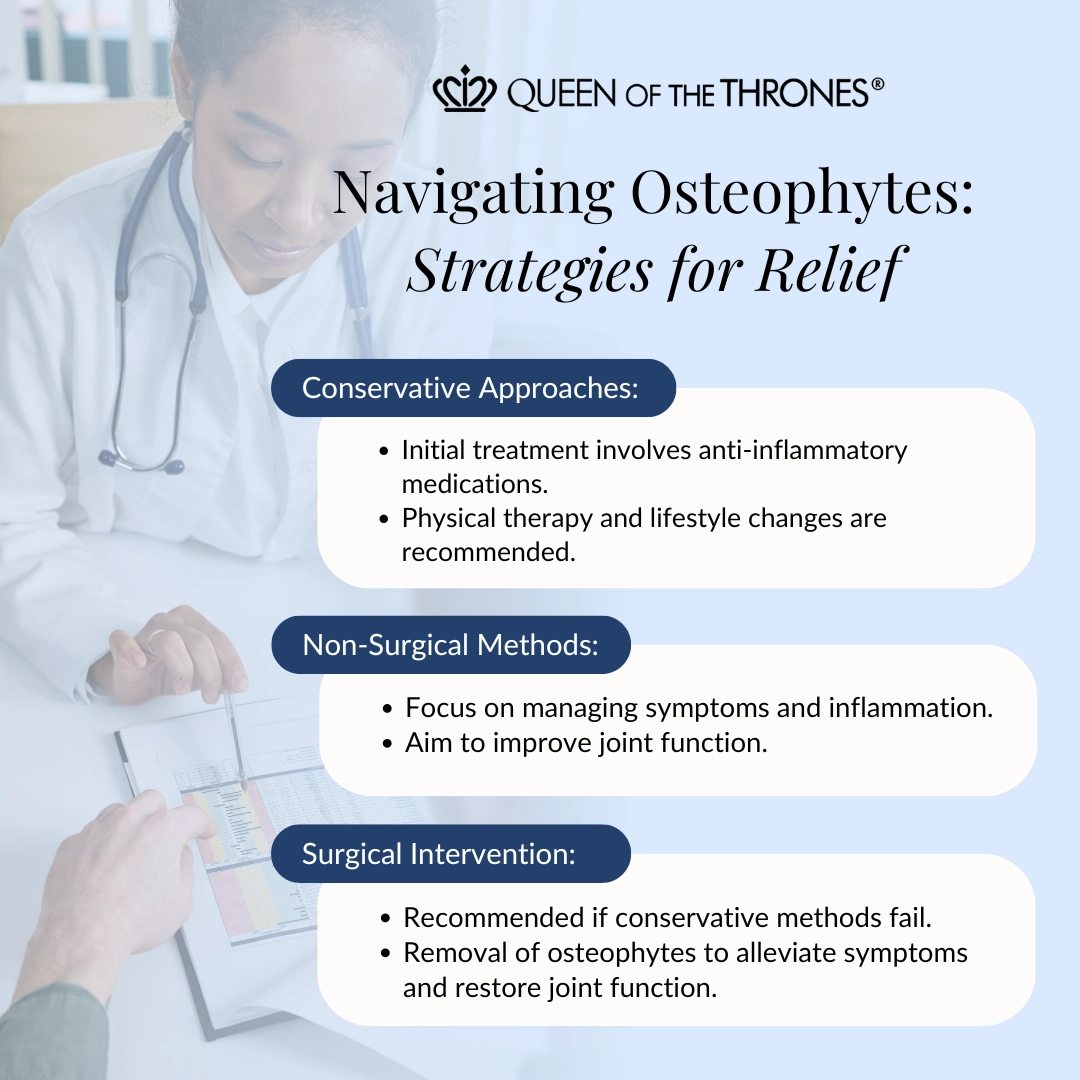
Natural support for bone spurs
Medications and surgical options aside, have you found yourself searching for a natural approach to your bone spurs?
You’re not alone, and there are things you can do to help support your body while following your healthcare provider’s advice.
Food support
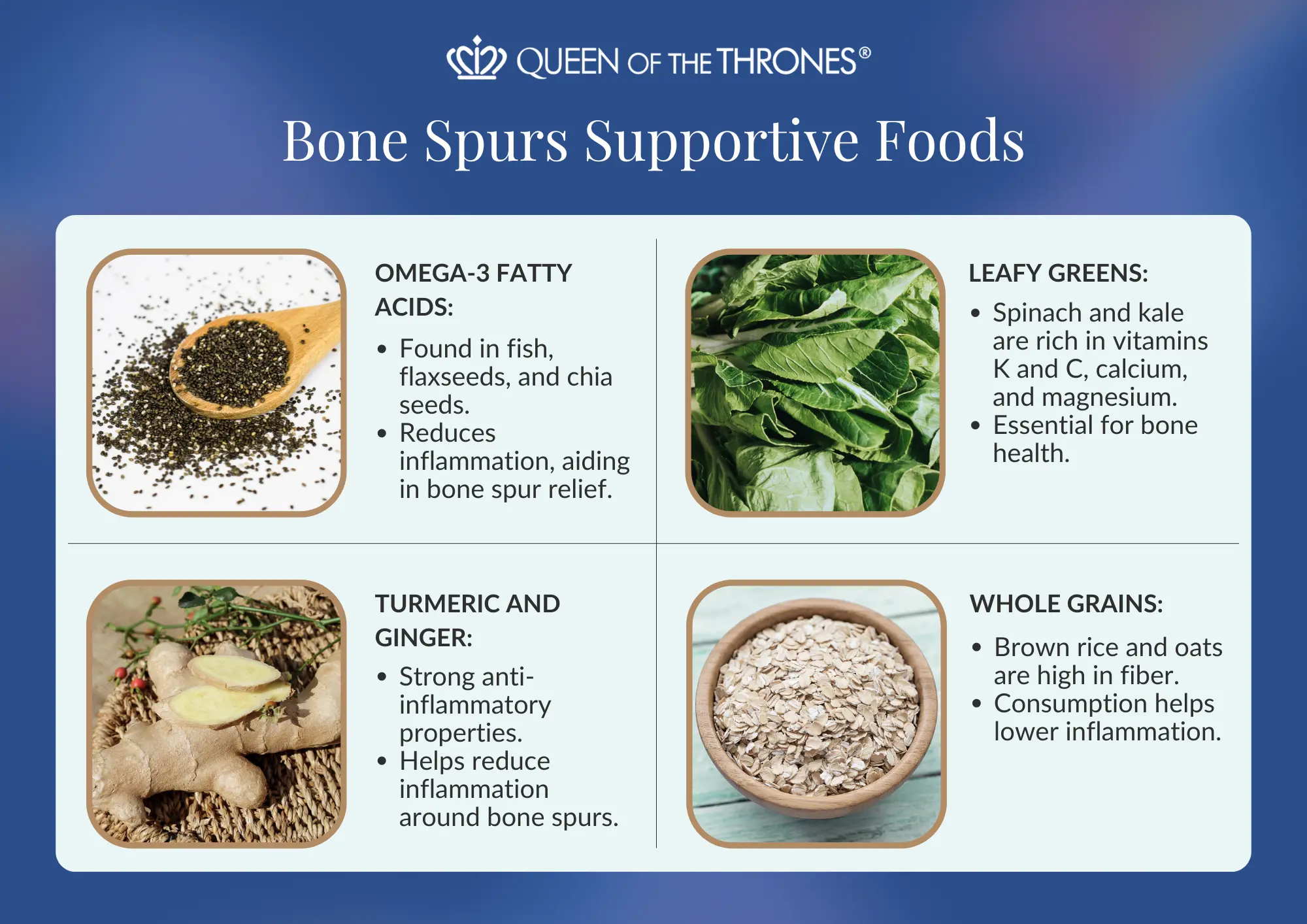
Omega-3 fatty acids, found in foods such as fish, flaxseeds, and chia seeds, play a significant role in reducing inflammation in the body.12 This anti-inflammatory effect may help alleviate symptoms associated with bone spurs.
Other supportive foods include:
Leafy Greens: Vegetables like spinach and kale are packed with vitamins K and C, along with minerals such as calcium and magnesium, essential for keeping your bones healthy.13
Turmeric and Ginger: Both of these spices have strong anti-inflammatory properties. Including them in your meals can help decrease inflammation around the bone spur, giving you relief.14
Whole Grains: Foods like brown rice and oats, which are whole grains, contain a lot of fiber. Eating them can help lower inflammation.15
So you see, embracing a nutritious diet rich in vitamins, minerals, and anti-inflammatory compounds holds the key to supporting overall bone health, potentially offering relief from bone spur symptoms and contributing to a more comfortable and active lifestyle.
Castor Oil and bone spurs
Have you heard of or considered Castor Oil as a potential support for the symptoms commonly associated with bone spurs?
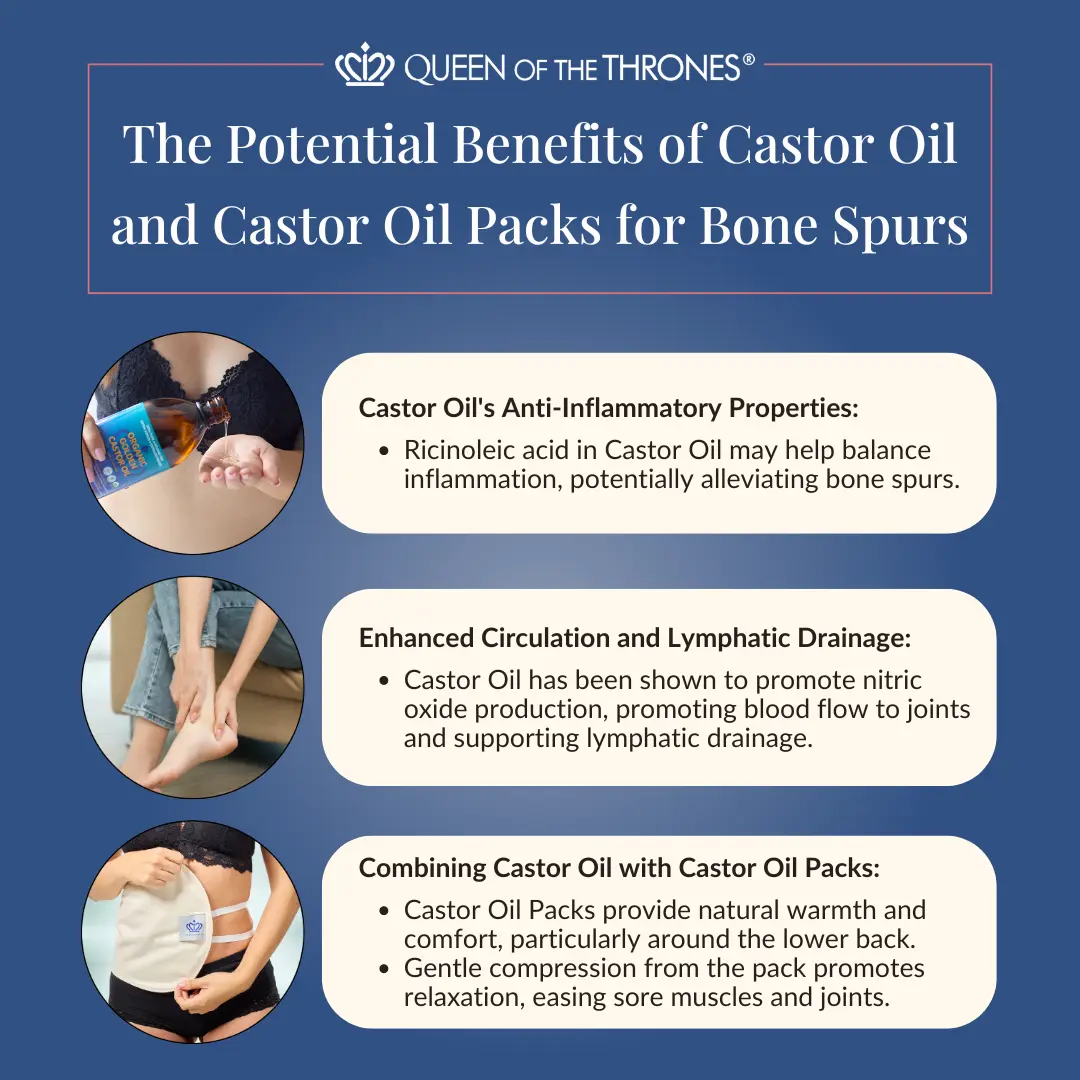
You see, Castor Oil contains anti-inflammatory properties, such as ricinoleic acid, which studies have shown supportive in balancing inflammation16.
Plus, because Castor Oil may also be able to support bringing circulation to your joints via nitric oxide stimulation17, while potentially supporting lymphatic drainage.18 So, it could be said that reduced inflammation may enhance blood flow to the joints, potentially bringing comfort to the inflamed area.
Now that we’ve looked at Castor Oil on its own, what about combining that with an actual Castor Oil Pack? Well, a Castor Oil Pack can make a versatile and supportive self-care option, wrapping around the lower back, providing natural warmth and comfort.
Plus, the gentle compression of a Castor Oil Pack is thought to help your body enter the ‘rest and digest’ state, supporting relaxation, which may help ease sore muscles and joints.19
Queen of the Thrones® Castor Oil Packs come in a wide variety, tailored to fit almost any part of your body:
- Back Castor Oil Pack
- Pelvis & Hips Castor Oil Pack
- Breasts Castor Oil Pack
- Thyroid Castor Oil Pack
- Liver Castor Oil Pack
Amazing, agreed? Supporting your self-care naturally has never been more simple!
Be sure to use organic Castor Oil that is 100% pure!
Queen of the Thrones® Castor Oil is always:
- USDA Organic & Non-GMO Project Verified – Avoiding pesticides, herbicides and GMOs
- Extra Virgin – The golden standard, first press of oil
- 100% Pure & Vegan Certified – No additives, preservatives, animal byproducts or anything other than straight up Castor Oil
- EWG Verified® & Hexane-Free – Adheres to stringent standards of the EWG and is processed without solvents like hexane; a known nervous system and hormone disruptor
- Bottled in Amber Glass – To preserve quality and nutrient profile of the oil, and avoid toxic chemicals found in plastic containers such as UV filters, slip agents and BPA
Would you love to learn more about Castor Oil Packs for your self-care routines?
Conclusion
While medical interventions and professional advice are essential aspects of managing bone spur symptoms, exploring natural approaches to self-care can also play a valuable role.
You see, Castor Oil, known for its anti-inflammatory properties,16A as backed by research, could be an easy self-care practice for you to help reconnect with your body.
Plus, as discussed above, the application of Castor Oil Packs may provide a sense of comfort from the outside in, just by the simple act of compression.
Sounds wonderful, agreed? We hope you enjoyed discovering natural ways to support your self-care, and find helpful insights in your free Castor Oil Pack eGuide!
Are you a practitioner, health coach or wellness influencer? If you’re interested in recommending our easy-to-use tools and practically applying them in your health and wellness professional practice, in clinic, or online with the people you serve, you can join now!
Click here for references
1. Stoll V, Jost JM, Jack A, Johnson T, Klein S, Darbhanga J, Hurwitz A, Mehra RS, Waters HB. Non-steroidal Anti-inflammatory Drugs and Osteopathic Manipulative Treatment for Pain Management in Patients With Osteoarthritis: A Literature Review. Cureus. 2023 Aug 26;15(8):e44168. doi: 10.7759/cureus.44168. PMID: 37753003; PMCID: PMC10519647.
- Zukowski LA, Falsetti AB, Tillman MD. The influence of sex, age and BMI on the degeneration of the lumbar spine. J Anat. 2012 Jan;220(1):57-66. doi: 10.1111/j.1469-7580.2011.01444.x. Epub 2011 Nov 4. PMID: 22050626; PMCID: PMC3248663.
- Gkastaris K, Goulis DG, Potoupnis M, Anastasilakis AD, Kapetanos G. Obesity, osteoporosis and bone metabolism. J Musculoskelet Neuronal Interact. 2020 Sep 1;20(3):372-381. PMID: 32877973; PMCID: PMC7493444.
- Rizzoli R, Biver E, Brennan-Speranza TC. Nutritional intake and bone health. Lancet Diabetes Endocrinol. 2021 Sep;9(9):606-621. doi: 10.1016/S2213-8587(21)00119-4. Epub 2021 Jul 6. PMID: 34242583.
- Adanaş C, Özkan S, Alp HH. The levels of 25-hydroxy vitamin D, parathyroid hormone, calcitonin and lipid profiles in patients with calcaneal spur. Turk J Phys Med Rehabil. 2022 Mar 1;68(1):55-61. doi: 10.5606/tftrd.2022.6799. PMID: 35949957; PMCID: PMC9305645.
- Kirkpatrick J, Yassaie O, Mirjalili SA. The plantar calcaneal spur: a review of anatomy, histology, etiology and key associations. J Anat. 2017 Jun;230(6):743-751. doi: 10.1111/joa.12607. Epub 2017 Mar 29. PMID: 28369929; PMCID: PMC5442149.
- Chu ECP, Lo FS, Bhaumik A. Plausible impact of forward head posture on upper cervical spine stability. J Family Med Prim Care. 2020 May 31;9(5):2517-2520. doi: 10.4103/jfmpc.jfmpc_95_20. PMID: 32754534; PMCID: PMC7380784.
- Velagala VR, Velagala NR, Kumar T, Singh A, Mehendale AM. Calcaneal Spurs: A Potentially Debilitating Disorder. Cureus. 2022 Aug 28;14(8):e28497. doi: 10.7759/cureus.28497. PMID: 36185871; PMCID: PMC9514376.
- Horecka A, Hordyjewska A, Blicharski T, Kurzepa J. Osteoarthritis of the knee – biochemical aspect of applied therapies: a review. Bosn J Basic Med Sci. 2022 Jul 29;22(4):488-498. doi: 10.17305/bjbms.2021.6489. PMID: 35151249; PMCID: PMC9392978.
- Klaassen Z, Tubbs RS, Apaydin N, Hage R, Jordan R, Loukas M. Vertebral spinal osteophytes. Anat Sci Int. 2011 Mar;86(1):1-9. doi: 10.1007/s12565-010-0080-8. Epub 2010 Apr 10. PMID: 20383671.
- Klaassen Z, Tubbs RS, Apaydin N, Hage R, Jordan R, Loukas M. Vertebral spinal osteophytes. Anat Sci Int. 2011 Mar;86(1):1-9. doi: 10.1007/s12565-010-0080-8. Epub 2010 Apr 10. PMID: 20383671.
- Sharma T, Mandal CC. Omega-3 fatty acids in pathological calcification and bone health. J Food Biochem. 2020 Aug;44(8):e13333. doi: 10.1111/jfbc.13333. Epub 2020 Jun 17. PMID: 32548903.
- Sim M, Lewis JR, Prince RL, Levinger I, Brennan-Speranza TC, Palmer C, Bondonno CP, Bondonno NP, Devine A, Ward NC, Byrnes E, Schultz CJ, Woodman R, Croft K, Hodgson JM, Blekkenhorst LC. The effects of vitamin K-rich green leafy vegetables on bone metabolism: A 4-week randomised controlled trial in middle-aged and older individuals. Bone Rep. 2020 Apr 26;12:100274. doi: 10.1016/j.bonr.2020.100274. PMID: 32455149; PMCID: PMC7235933.
- Heidari-Beni M, Moravejolahkami AR, Gorgian P, Askari G, Tarrahi MJ, Bahreini-Esfahani N. Herbal formulation “turmeric extract, black pepper, and ginger” versus Naproxen for chronic knee osteoarthritis: A randomized, double-blind, controlled clinical trial. Phytother Res. 2020 Aug;34(8):2067-2073. doi: 10.1002/ptr.6671. Epub 2020 Mar 16. PMID: 32180294.
- Liu T, Xu C, Driban JB, Liang GY, Zhang XH, Hu FB, McAlindon T, Lu B. Whole grain consumption and risk of radiographic knee osteoarthritis: a prospective study from the Osteoarthritis Initiative. Rheumatology (Oxford). 2023 May 2;62(5):1834-1840. doi: 10.1093/rheumatology/keac517. PMID: 36130461; PMCID: PMC10152291.
16-16A. Vieira C et al. .Effect of ricinoleic acid in acute and subchronic experimental models of inflammation. Mediators Inflamm. 2000;9(5):223-8 PMID: 11200362
- Mascolo N, Izzo AA, Autore G, Barbato F, Capasso F. Nitric oxide and castor oil-induced diarrhea. J Pharmacol Exp Ther. 1994 Jan;268(1):291-5. PMID: 8301570.
18. Moore JE Jr, Bertram CD. Lymphatic System Flows. Annu Rev Fluid Mech. 2018 Jan;50:459-482. doi: 10.1146/annurev-fluid-122316-045259. PMID: 29713107; PMCID: PMC5922450.19. Rolls ET et all. Representations of pleasant and painful touch in the human orbitofrontal and cingulate cortices. Cereb Cortex. 2003 Mar;13(3):308-17. PMID: 12571120

